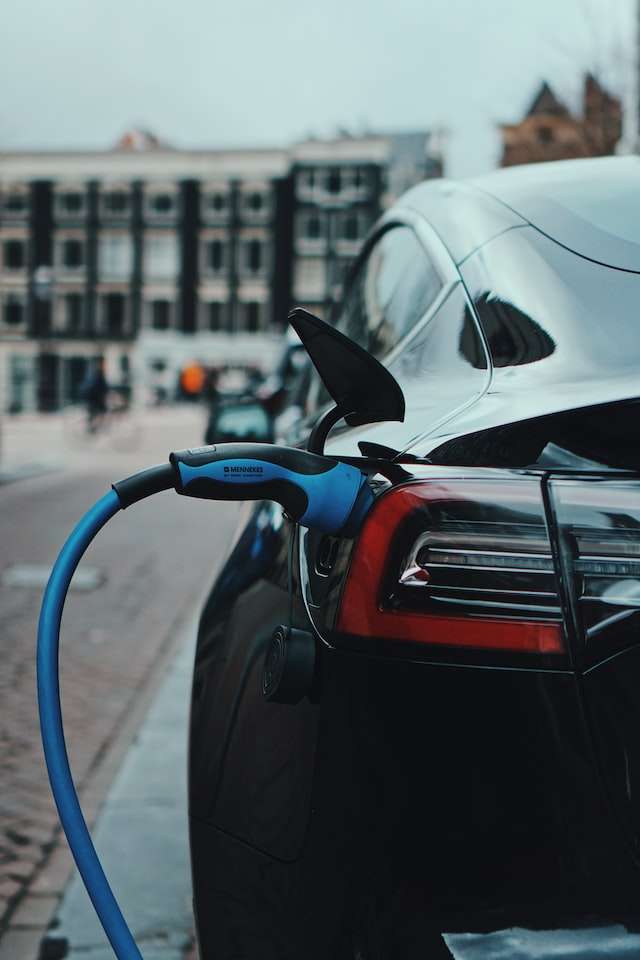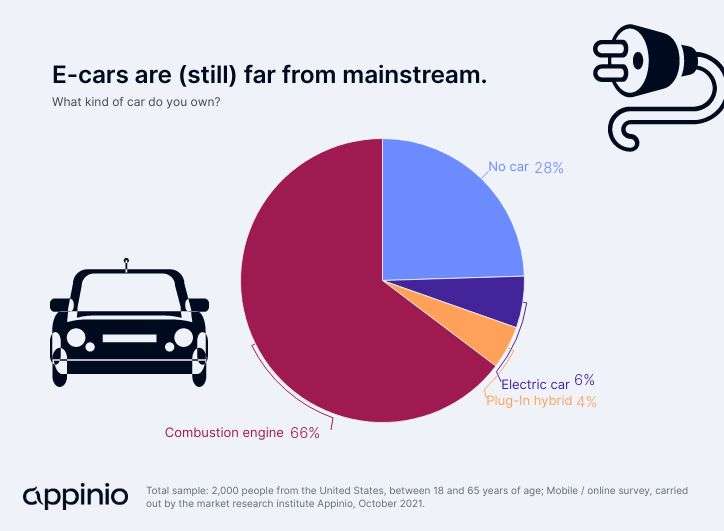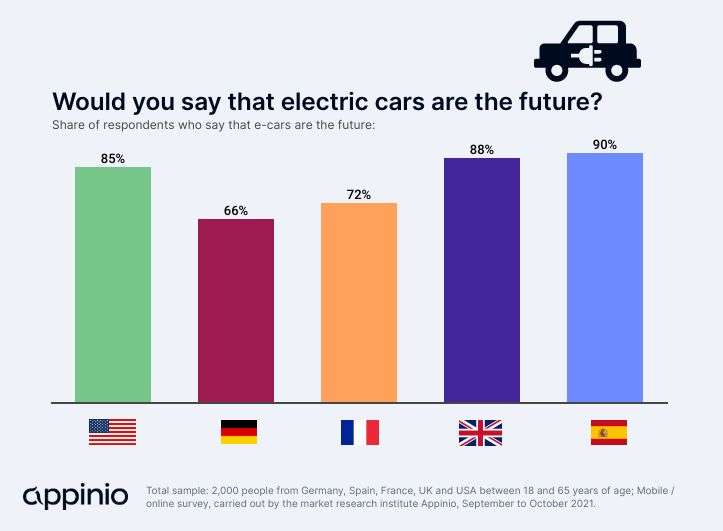E-mobility guide: everything you need to know about electric cars
Appinio Research · 17.11.2021 · 21min read

Content
Hardly makes any noise, does not emit any smelly exhaust fumes and contains a lot of the latest technology - at least that is the general perception of the electric car. However, electromobility is much more than that; the emission-free electric motors, fed with climate-neutral energy, are the technological promise that should lead us into a more environmentally friendly future.
Demand is also growing rapidly and politics could set the course for electromobility in the United States in the near future, which is why it's time for a detailed look at the subject.
What does e-mobility mean? What is there to know about e-cars? How do Americans think about electromobility?
With the Mobility Report 2021, Appinio is presenting an extensive survey in five countries. For the representative study (by age and gender), a total of 10,000 consumers in the United States, Germany, France, Spain, and the United Kingdom were interviewed and asked about their opinion on e-cars around the world.
This E-Mobility Guide presents the most exciting insights into the results and tells you everything you should know about electric mobility.
💡Can't wait to read all the insights? Then download the full report for free!
What is an electric car?
An electric car differs from a conventional car in one essential area: the engine.
Instead of diesel or gasoline, the electric car is driven by electricity. A rechargeable battery or a battery supplies the motor.
Instead of going to the gas station, the driver of an electric car has to make their way to a public charging station or can conveniently plug up their car's battery pack at home.
It is surprising that our streets are not paved by electric cars, after all, the idea of an electric car is more than 100 years old.
At the beginning of the 21st century, researchers worked on prototypes, but they failed because the technology of the time had not caught up yet.
Another notable reason is that oil was cheaper and has long since established itself as the economic driver of the 21st century.
It was not until the 2000s that the electric car returned to the focus of automakers.
Since then, brands such as Tesla, VW, Renault, Hyundai, Audi and BMW have regularly presented new models. In the future, nobody will be able to ignore e-cars, because they are an important piece of the puzzle in the energy transition.
Many countries also want to ban the registrations of cars with conventional combustion engines in the coming years.

The idea of an environmentally friendly and climate-neutral future can no longer be imagined without the electric car.
The vast majority of Americans (85%) also think: EVs are the future.
However, in contrast to the conventional engine that has existed for over 100 years, the technology is still in its infancy.
Apart from car types such as cars, SUVs, pick-ups or buses, there are already different versions of e-cars with regard to the drive system that combine the past and the future or are already being traded as the next evolutionary stage in electromobility.
- Battery-powered e-car
What we know as a classic electric car is usually the Battery Electric Vehicle (BEV). This type of electric car runs exclusively on electricity that is stored in a battery. This can be charged either at home or at a public charging station. Compared to the conventional car, this type of electric car has neither a gearbox nor a gearshift. - Plug-in car
If the electricity comes by cable from the charging station via the integrated socket into the car, we speak of plug-in cars. There is a purely battery-powered version, but also a hybrid version with a combustion engine. The additional electric motor supports the conventional main motor in order to reduce energy consumption. - Hybrid car with a conventional engine
This type of e-car combines the old with the new. There are two drive technologies in hybrid cars - electronic and classic with fossil fuels such as gasoline or diesel. The hybrid car covers the majority of the route with conventional fuels, but the electric motor assists in energy-intensive actions such as starting, accelerating, braking, etc. The additional electronic motor optimizes the combustion engine and reduces energy consumption. - Hybrid car with an electronic motor
The main drive in hybrid vehicles is electronic. The built-in combustion engine increases the effective range once the battery is empty. However, this conventional motor does not drive the electric car but feeds a generator, which in turn charges the battery. - Fuel-Cell Electric Vehicle
An exception among electric vehicles is the variant with integrated fuel cells. The energy in the cells is generated by the reaction of oxygen with hydrogen. They are climate-neutral and absolutely emission-free, as the only emission is water. The big problem: The fueling options for hydrogen are still very limited in the US and around the world. Nevertheless, these e-cars are seen as the next evolutionary stage when the use of hydrogen becomes more suitable for the masses.
(Almost) every road leads to an EV...
Innovations traditionally have a difficult start on the market: The technologies are immature and expensive, so that, above all, only high earners can afford them.
For the time being, e-cars will remain expensive until a critical mass of consumers is reached and a solid market emerges. Rare raw materials for motors and batteries determine the high price and high acquisition costs make many people hesitate.
For example, the first association for nearly the majority of Americans (48%) is simply “expensive prices”.
The high price is justified by the use of rare raw materials to build the motor and batteries, and it is understandable that these high initial costs make many potential customers waver. However, the advantages of an electric vehicle outweigh the disadvantages in the long run.
First, an EV puts less of an ecological strain than its fossil-fuel predecessor in the long-term. Secondly, an electric motor is emission-free and much quieter than a combustion engine, which causes less atmospheric & noise pollution.
One could argue that providing electricity to feed EVs also causes strain on the environment as we need factories to produce electricity, but this needs a more holistic approach. Green & renewable technologies, like solar and wind power, will keep spreading and becoming standard practice, therefore, the carbon footprint of EVs is going to be even lower.
Another interesting point that sparks a lot of debate is the heart of electric vehicles: the battery. Contrary to popular belief, the battery of an EV can live a second life. Due to wear-and-tear, EV batteries need to be replaced after some years, but they can be recycled and become another energy storage device. If a combustion engine gets irreversibly damage, it can no longer be used and therefore gets thrown away.
Finally, an electric motor is clearly ahead in terms of maintenance: on average, an ICE consists of more than 1000 parts. An electric motor, including a battery, has only about 200 components. The technology in the EV is lighter, more compact, less prone to failure, making it easier to care for.
... apart from refuelling
A disadvantage in addition to the currently still high prices is the range of an electric car.
The charging station network is also not yet as dense as the petrol station network. In the United States, charging stations are unevenly distributed, with California having around the same number of stations as the 39 states with the lowest amount combined.
The slow expansion is slowing down the triumph of the electric car in the years to come.
This also fuels prejudices about e-cars: over half of those surveyed (52%) consider the charging infrastructure for e-cars to be suitable for everyday use - among owners of conventional cars it is even less (22%).
EV owners seem to be able to come to terms with it, however, because three times as many respondents (68%) consider the infrastructure to be suitable for everyday use.
Interestingly, more than two-thirds of non-owners find the installed batteries sufficient for everyday use (62%). This share is greater among owners of an electric car; 73% of them feel that the installed batteries are sufficient for their everyday lives.
💡Can't wait to read all the insights? Then download the full report for free!
The state of electric cars in the United States
Pretty much every major car manufacturer is active in the e-mobility space.
We can find established players in the mobility field like Toyota, Ford, BMW, Audi, or Honda, but the superstar of electric mobility is only one: Tesla.
Under the leadership of the infamous Elon Musk, the American company has existed since 2003 and brought the first e-series car onto the market in 2008, creating a cult-like following!
In addition to electric cars, the company has also been producing batteries and solar systems in-house. Tesla now offers six model series and, according to its own figures, sold almost 500,000 vehicles in 2020. A large-scale factory, the "Gigafactory" in Berlin-Brandenburg, is to be completed this year in order to further boost production and satisfy the high demand more quickly.
The Appinio study also confirms the stardom of Tesla: two out of three EV owners drive a Tesla (67%).
Tesla also stands out as a top-of-mind brand: more than a third (39%) think of Tesla first when they hear the word electric car. No other brand is so often associated with the positive attributes of innovative, futuristic and environmentally friendly as Tesla.
Only when it comes to aspects such as passion and speed can competitors like Porsche outperform the American manufacturer.
Increasing demand in the American market
In the United States, the electric vehicle market has developed slowly for a long time, but sales figures have been increasing strongly for several years.
While around 200,000 plug-in cars were sold in 2017, by 2019 there was already over 337,000 in circulation.
By 2021 there are already 148,000 e-cars and 163,000 plug-in hybrids.
Between the second quarter of 2020 and the second quarter of 2021, EV sales in the US quadrupled, leading to a share of 3.6 percent of total domestic car sales.
With the goal of making zero-emissions cars account for half of all new vehicle sales in the US by 2030, the Biden administration's infrastructure plan proposes spending billions on expanding EV charging stations.
New registrations for internal combustion engines with petrol, diesel or natural gas are declining, while registrations for hybrid, plug-in and electric cars are increasing rapidly. Is this a good signal for the electric mobility industry or are consumers only trying an easy alternative to ICE cars?
Hurdles, purchase criteria and predominant brands - what do Americans really think about EVs?
Electric cars are not yet riding the mainstream wave.
The Appinio study shows that two-thirds of Americans (66%) still drive an ICE car, and only one in 10 (10%) drives a fully electric or plug-in hybrid. Nearly half of the owners of a combustion engine (46%) say that their next car will probably be electric. Those who already drive electric cars are very likely to opt for an electric car again (88%).
💡Can't wait to read all the insights? Then download the full report for free!
The majority have never sat in an EV, but the desire to try it out is great
The majority of non-owners have not yet even had the pleasure of experiencing an electric car, two thirds (69%) have never been in an EV.
But interest is high, 78% would like to test drive an electric car.
Especially in big cities, people have more contact with EVs in daily traffic or via taxi services & car sharing.
Those who have already had the pleasure of a joyride were generally enthusiastic: the majority (65%) found the test run (very) positive.
The greatest wow effects were provided by the car's silence (54%) and the comfort of the car (49%).
E for Environmentally friendly & Expensive
The ban on combustion engines from 2030 onwards is contested in the US, with 53% supporting it. And 64% of Americans believe that politicians should offer more purchase incentives and subsidies to accelerate the switch to e-mobility.
The first thing Americans associate with EVs is the expensive price (48%) and environmental friendliness (47%). EV owners think about its futuristic quality (37%), environmental friendliness (36%) and innovativeness (33%) and driving pleasure (30%).
When it comes to general purchase criteria, nothing is as important as the price (80%) and safety (79%) of a car.
The type of car - i.e. electric or ICE - comes only in fourth place (78%).

Perception of e-mobility brands: Tesla takes it all
No brand is more associated with electromobility among Americans than Tesla.
As mentioned, more than a third of Americans think of Tesla when the word electric car is mentioned (39%). The brand is also the most associated with e-mobility (77%).
Behind expensive prices (64%), Americans associate Tesla with futurism & innovation (58% and 51% respectively) - which puts Elon Musk's company in first place in each of these dimensions. Also when it comes to environmental friendliness, the American manufacturer outshines all other brands.
Let’s have a look at other big brands:
- Mercedes & Porsche edge out Tesla when it comes to their attractiveness (both 45% vs. 43%).
- When it comes to speed and passion in the e-segment, no one stands out as much as Porsche (49% and 26% respectively).
- The driving pleasure category is won by Porsche (39%), followed closely by Mercedes & BMW (both 37%).
International comparison: EVs in Germany, France, Spain and the UK
The Appinio study was also conducted in other countries to get a more comprehensive overview of the market and offer the chance to make international comparisons on the topic of e-mobility.
For example, the Spanish and British respondents stand out with a particularly high level of acceptance for e-mobility: Nine out of ten respondents from Spain (90%) and Britain (88%) are confident to see EVs as part of the future.
In Germany, only two thirds (66%) say the same, France and the USA are in the middle (72% and 81% respectively). Support for a ban on new registrations of combustion engines from 2030 is also highest in the UK and Spain (70% and 69% respectively).
While the USA is divided (52% in favour), skepticism is high in Germany and France (only 44% each in favour).
These differences seem surprising if we look at the prevalence of EVs in each country: 13% of the Germans, French & Brits own an EV, in Spain it is marginally less (12%), in the USA it is 10%.
The French & Germans focus on costs, the Spanish & British dream of the environment
We have already seen that electric cars are often associated with high prices & the same applies to all five countries.
This is also the first thing that comes to mind for the French & Germans above all other countries (61% & 54% respectively).
The Spaniards, on the other hand, associate electric mobility predominantly with environmental friendliness (57%). In the USA respondents vacillate between environmental friendliness and high prices (46% and 48%) - similar to the UK.
The topic of futurism enjoys the highest priority in the USA (39%). Interestingly to note that, in all five markets, the older the respondents, the more likely they are to associate EVs to expensive prices.
When it comes to the brands that are most associated with e-mobility, Tesla is clearly ahead in every country surveyed. Only in France does the domestic manufacturer Renault engage in a serious tête-à-tête with the industry leader (43% vs. 47%).
Toyota is also well placed in the public eye in Spain, France and the USA (26%, 25% and 25% respectively), in Germany, the Japanese manufacturer only comes in sixth place behind VW, BMW, Audi and Mercedes-Benz (11%).
Conclusion: The electric train is (slowly) taking off towards a climate-neutral future
While Europe is steadfastly heading towards an EV future, America's trajectory still remains unclear.
The Biden administration is clearly looking towards sustainability and combatting climate change, but, as we've seen in the past, these goals could be completely circumvented with the election of a new administration.
Public opinion is also integral to ensure these goals are met. Car manufacturers regularly entice customers with new models, and political "environmental bonuses" are changing the minds of more and more undecided drivers.
Since last year, the sales figures for electric cars in the US have been rising strongly, and promising figures are forecast for 2021.
The topic of electric mobility is increasingly present in the media, at work, in leisure time or among friends and acquaintances! In order to speed up adoption, there needs to be further financial incentives & more education from business and politics as well as more efforts into expanding the public charging station infrastructure.
The international results of the Appinio Mobility Report 2021 give a clear message: Interest and demand are definitely there!

Would you like to delve deeper into the results of this study?
More about Appinio
The market research platform Appinio enables companies worldwide to receive thousands of opinions from specific target groups in just a few minutes. For the first time, anyone can validate decisions and ideas in real time. As the fastest solution for market research, Appinio provides feedback from 50+ markets and helps companies to turn agility and consumer centricity into reality.
Get facts and figures 🧠
Want to see more data insights? Our free reports are just the right thing for you!
